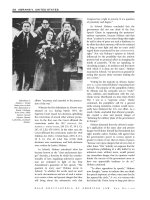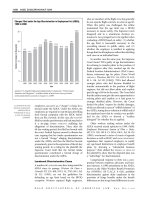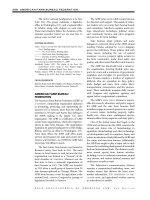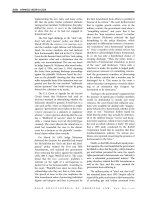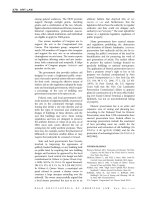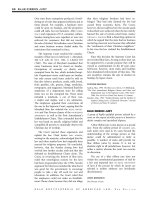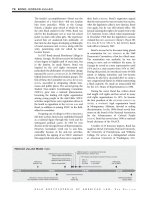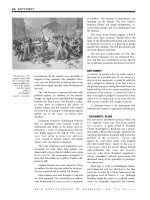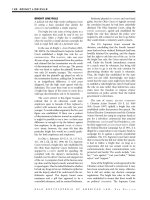Gale Encyclopedia Of American Law 3Rd Edition Volume 7 P5 pptx
Bạn đang xem bản rút gọn của tài liệu. Xem và tải ngay bản đầy đủ của tài liệu tại đây (289.03 KB, 10 trang )
the Medicaid program. Consequently, health care
providers are not fully reimbursed for the services
they provide to Medicaid patients. Because of
lower reimbursement payments, one-third of
physicians limit the number of Medicaid patients
they see, and one-fourth of them refuse to accept
any Medicaid patients.
The federal government, through statutes and
regulations, has enacted an increasing number of
criteria for the states to follow in administering
the Medicaid program. For example, from 1987
to 1992, the federal government imposed 30
mandates on states connected to eligibility,
reimbursement, and services. The intent of these
A sample mechanic’s
lien
ILLUSTRATION BY GGS
CREATIVE RESOURCES.
REPRODUCED BY
PERMISSION OF GALE, A
PART OF CENGAGE
LEARNING.
Mechanic’s Lien
Claim of Lien (Mechanic’s Lien) California Civil Code §3084
Claimant, ,
(Address)
hereby claims a mechanic’s lien as follows:
Dated:
(Print or Type Name/Title)
VERIFICATION
(Claimant) By:
1. Claimant’s demand, after deducting all just credits and offsets, is $ , plus interest at the rate of ____ % per annum from
(date)___________________
2. The name of the owner or reputed owner, if known, is:
3. Claimant furnished the following kinds of labor, services, equipment or materials:
4. Said labor, services, equipment or materials were performed or furnished at:
5. The name of the person by whom the Claimant was employed or to whom the Claimant furnished the labor, services, equipment or
materials is:
Dated:
(Personal signature of person providing the verification)
STATE OF CALIFORNIA
COUNTY OF
I, the undersigned, say: I am the _______________________________________ of the claimant of the foregoing mechanic’s lien; I have
read said claim of mechanic’s lien and know the contents thereof; the same is true of my own knowledge. I declare under penalty of perjury
that the foregoing is true and correct. Executed on ____________________ _, ____, at , California
On before me,
, (here insert name and title of the officer), personally appeared
___________________________________________, who proved to me on the basis of satisfactory evidence to be the person(s) whose
name(s) is/are subscribed to the within instrument and acknowledged to me that he/she/they executed the same in his/her/their authorized
capacity(ies), and that by his/her/their signature(s) on the instrument the person(s), or the entity upon behalf of which the person(s) acted,
executed the instrument. I certify under PENALTY OF PERJURY under the laws of the State of California that the foregoing paragraph is
true and correct.
WITNESS my hand and official seal.
Signature
}
} S.S.
GALE ENCYCLOPEDIA OF AMERICAN LAW, 3RD E DITION
28 MEDICAID
mandates was to reduce variations among the
states and to create more consistency in the
coverage to low-income persons.
Under federal law, states cannot reduce other
welfare benefits that people receive when they
become eligible for Medicaid. State plans cannot
impose a citizenship or residency requirement
other than requiring that an applicant be a
resident of the state. No age requirement exists,
and everyone receiving welfare may apply for
Medicaid. People who are “medically needy”
because they are unable to cover costs for their
medical care are also eligible, even if their
incomes or resources exceed the level that would
qualify them for welfare. Beginning in 1988,
Medicaid was extended to the “working poor”—
low-income persons who have jobs with no
health coverage.
When Medicaid began, persons who were
eligible had the right to select their own doctors,
hospitals, or other medical facilities. Because of
skyrocketing medical expenditures, almost all
states have received waivers from the federal
government concerning the choice of physician.
These states direct most of their Medicaid clients
to private,
MANAGED CARE programs. Managed care
is a general term that refers to health plans that
attempt to control the cost and quality of care by
coordinating medical and other health-related
services.
The federal government has also granted
waivers to states that prefer to pay for home and
community care for elderly beneficiaries who
otherwise would end up in nursing homes. This
type of care is less expensive than nursing home
care and allows state funds to be stretched
further.
The federal government reimburses states
based mainly on their
PER CAPITA inco me. States
with high per capita incomes, such as New
York and Illinois, receive 50 cents from the
federal government for every dollar they spend
on Medicaid. Poorer states receive more, with
Mississippi receiving reimbursement of 76
percent. The average reimbursement level is
57 percent.
Medicaid
FRAUD has plagu ed the program.
The size and complexity of the system, with
each state administering Medicaid differently,
create opportunity for health care providers
and state employees to engage in abuse. It
is estimated that 10 percent of Medicaid
expenditures are paid on fraudulent claims by
vendors. Relatively little fraud is attributable
to individuals who provide false information
to receive Medicaid benefits.
Another problem for Medicaid has been the
growing number of middle-class, elderly per-
sons who divest their assets, usually to their
children, to meet the Medicaid financial guide-
lines and qualify for state-paid nursing home
care. This practice resu lts in cases where the
truly needy cannot find a bed in a nursing
home. In addition, the divestiture of assets
imposes additional financial pressures on a
program that already has difficulty meeting
the demands of the truly needy. If an individual
or couple gives away or sells a resource at less
than
FAIR MARKET VALUE, the Social Security
Administration must report such a transfer to
the state Medicaid agency. A
TRANSFER OF ASSETS
may result in a period of ineligibility for certain
Medicaid-covered nursing home services.
In Wisconsin Department of Health and
Family Service v. Blumer, 534 U.S. 473, 122 S.
Ct. 962, 151 L. Ed. 2d 935 (2002), the U.S.
Supreme Court upheld a Medicaid formula for
determining Medicaid eligibility for a person
needing nursing home care. More than 30 states
developed Medicaid rules that used an income-
first formula, while the remainder of the states
Medicaid Recipients, 2005
SOURCE: Centers for Medicare & Medicaid Services,
Medicaid Program Statistics, Medicaid Statistical
Information S
y
stem (MSIS).
Children
26,337,000
Adults
12,529,000
Children in
foster care
875,000
Aged 65 and over
4,396,000
Blind/disabled
8,210,000
Other and unknown
5,296,000
ILLUSTRATION BY GGS
CREATIVE RESOURCES.
REPRODUCED BY
PERMISSION OF GALE, A
PART OF CENGAGE
LEARNING.
GALE ENCYCLOPEDIA OF AMERICAN LAW, 3
RD E DITION
MEDICAID 29
used a resource-first formula to help determine
eligibility for Medicaid assistance and the
proper amount of income for the community
spouse. The income-first rule generally calls
upon the community spouse to count more of
his or her assets toward his spouse’s nursing
home care. The resource-first rule allows the
spouse to keep more assets, in the belief that
income from these assets will help to support
the community spouse.
The state of Wisconsin used the income-
first formula. A married coupled challenged this
formula, and the U.S. Supreme Court deter-
mined that either formula could be used by a
state without violating the Medicare Cata-
strophic Coverage Act of 1988 (MCCA). The
Court placed great emphasis on the fact that the
HEALTH AND HUMAN SERVICES DEPARTMENT (HHS)
had issued several statements in support of the
income-first rule and noted that in late 2001
HHS had proposed a rule that would formalize
this support.
The seriousness of these fraudulent transfers
led Congress in 1996 to make a person
criminally liable who “knowingly and willfully
disposes of assets (including by any transfer in
trust) in order for an individual to become
eligible for medical assistance” (42 U.S.C.A.
§ 1320a–7b[a]). A person conv icted of this
offense may be fined $25,000 and imprisoned
for five years.
The Balanced Budget Act of 1997 provided a
new opportunity for states to further expand
health insurance coverage for children under
Medicaid. The legis lation created a new State
Children’s Health Insurance Program under
Title XXI of the Social Security Act. Funding is
available to states for this voluntary program. A
state’s allotment may be used to expand
Medicaid, to develop a new program or to
expand an existing program to provide health
insurance to uninsured children, or to imple-
ment a combination of the two approaches. Up
to 10 percent of a state’s allotment may be used
for administrative costs, outreach, or other
health care services for children. The new funds
must be used to serve children below age 19
living in families with incomes at or below 200
percent of the federal poverty level.
The increase in state and federal expendi-
tures on Medicaid (more than $319 billion in
2007) and in federal mandates to states on
administration of the program have led to calls
for reform. Shortly after taking office in 2009,
President
BARACK OBAMA increased Medicaid
payments to state governments as a part of an
economic stimulus package and pressed law-
makers to repair a health care system that he
termed as broken. Among the proposals being
considered by Congress in 2009 was a dramatic
expansion and redefinition of the Medicaid
program. The proposal would redefine who is
eligible for benefits in an effort to achieve
universal health coverage. Under the current
Medicaid system, many low-income individuals
who earn less than 200 percent of poverty are
not eligible for benefits . The proposed reform
would extend coverage to these individuals, an
estimated 11 million, but at a substantial cost to
the government. The nation’s governors op-
posed the proposal, arguing that their budgets
are already strained by the Medicaid’s increasing
costs. Although the idea of health care reform
was viewed by many as favorable, the type of
reform and how it should be paid for remained
subject to considerable debate.
FURTHER READINGS
Atlantic Publishing Company. 2008. The Complete Guide to
Medicaid and Nursing Home Costs. Ocala, Fla.: Atlantic
Publishing Group.
Bishop, Harold M., and Amber Bollman. 2009. Medicare
and Medicaid Benefits. Chicago: Wolters Kluwer-CCH.
The Henry J. Kaiser Family Foundation. Medicaid/CHIP.
Available online at www.statehealthfacts.org (accessed
July 22, 2009).
Koren, James Rufus. 2009. “Immigration Activists Seek
Quicker Access to Medicaid.” San Bernardino County
Sun. December 31.
Tumulty, Karen. 2009. “Medicaid and the States.” Time.
(July 21).
CROSS REFERENCES
Health Care Law; Health Insurance
MEDICAL EXAMINER
A public official charged with investigating all
sudden, suspicious, unexplained, or unnatural
deaths within the area of his or her appointed
jurisdiction. A medical examiner differs from a
CORONER in that a medical examiner is a
physician. Medical examiners have replaced
coroners in most states and jurisdictions.
Medical examiners determine such things as
the positive identification of a corpse, the time
of death, whether death occurred at the location
where the corpse was found, and the manner
and cause of death. They conduct autopsies and
other medical tests to determine any or all of
GALE ENCYCLOPEDIA OF AMERICAN LAW, 3RD E DITION
30 MEDICAL EXAMINER
the details of death. They often work in
conjunction with a legal team, such as a state
prosecutor’s office, and will testify at trial as
to their findings and determinations. In that
regard, a medical examiner’s testimony is that
of an expert witness, subject to cross-examina-
tion by counsel or refutation by the testimony
of other expert witnesses.
MEDICAL MALPRACTICE
Improper, unskilled, or negligent treatment of a
patient by a physician, dentist, nurse, pharmacist,
or other
HEALTH CARE professional.
NEGLIGENCE is the predominant theory of
liability concerning allegations of medical mal-
practice, making this type of litigation part of
TORT LAW. Since the 1970s, medical MALPRACTICE
has been a controversial social issue. Physicians
have complained about the large number of
malpractice suits and have urged legal reforms to
curb large damage awards, whereas tort attorneys
have argued that negligence suits are an effective
way of compensating victims of negligence and of
policing the medical profession.
A person who alleges negligent medical
malpractice must prove four elements: (1) a
duty of care was owed by the physician; (2) the
physician violated the applicable standard of
care; (3) the person suffered a compensable
injury; and (4) the injury was caused in fact and
proximately caused by the substandard conduct.
The burden of proving these elements is on the
plaintiff in a malpractice lawsuit.
Physicians, as professionals, owe a duty of
care to those who seek their treatment. This
element is rarely an issue in malpractice
litigation, because once a doctor agrees to treat
a patient, he or she has a professional duty to
provide competent care. More important is that
the plaintiff must show some actual, compen-
sable injury that is the result of the alleged
negligent care. Proof of injury can include the
physical effects of the treatment performed by
the physician, but it can also include emotional
effects. The amount of compensation at issue is
usually a highly contested part of the litigation.
Causation may also be a vigorously litigated
issue because a physician may allege that the
injuries were caused by physical factors unrelat-
ed to the allegedly negligent medical treatment.
For example, assume that a physician is sued for
the negligent prescription of a drug to a patient
with coronary artery disease and that the patient
died of a heart attack. The plaintiff’s estate
cannot recover damages for the heart attack
unless there is sufficient proof to show that the
medication was a contributing cause.
The critical element is standard of care,
which is concerned with the type of medical
care that a physician is expected to provide.
Until the 1960s the standard of care was
traditionally regarded as the customary or usual
practice of members of the profession. This
standard was referred to as the “locality rule,”
because it recognized the custom within a
particular geographic area. This rule was criti-
cized for its potential to protect a low standard
of care as long as the local medical co mmunity
embraced it. The locality rule also was seen as a
disincentive for the medical community to
adopt better practices.
Most states have modified the locality rule
to includ e both an evaluation of the customary
practices of local physicians and an examination
of national medical standards. Physicians are
called to testify as expert witnesses by both sides
in medical malpractice trials because the jury is
not familiar with the intricacies of medicine.
Standards established by medical specialty
organizations, such as the American College of
Obstetricians and Gynecologists, are often used
by these expert witnesses to address the alleged
negligent actions of a physician who practices in
that specialty. Nonconforman ce to these stan-
dards is evidence of negligence, whereas con-
formance supports a finding of due care.
Other rules govern the standard of care
evaluation. A few states apply the “respectable
minority rule” in evaluating a physician’s
conduct. This rule holds that a physician is
not negligent merely by electing to pursue one
of several recognized courses of treatment.
Some states use the “error in judgment rule.”
This principle exempts a physic ian from liability
if the malpractice is based on the physician’s
error in judgment in choosing among different
methods of treatment or in diagnosing a
condition.
Medical malpractice litigation began to
increase in the 1960s. Tort lawyers were able
to break the traditional “conspiracy of silence”
that discouraged physicians from testifying
about the negligence of colleagues or serving
as expert witnesses. By the 1970s physicians
alleged that malpractice claims were interfering
GALE ENCYCLOPEDIA OF AMERICAN LAW, 3RD E DITION
MEDICAL MALPRACTICE 31
with their medical practices, with insurance
companies either refusing to write malpractice
policies for them or charging inflated
premiums.
Over the years, physicians and health care
providers argued that malpractice claims were
also driving up the cost of health care. They
contended that jury verdicts in the millions of
dollars had to be passed on to the consumer in
the form of higher insurance premiums and
physician fees. In addition, man y physicians
were forced to practice “defensive medicine” to
guard against malpractice claims. Defensive
medicine refers to the conducting of additional
tests and procedures that are not medically
necessary but that would assist in defeating a
negligence claim.
In response to rising malpractice suits, many
states pushed for “tort reform” measures. Such
measures limit the amount of damages a patient
can recover for noneconomic losses, such as pain
and suffering, and
PUNITIVE DAMAGES.Forexam-
ple, in 1975, California enacted the Medical
Injury Compensation Reform Act, which limits
recovery of noneconomic damages at $250,000
and restricts the amount of fees that may be
recovered by lawyers. Several other states
adopted similar measures based on the California
model.
The medical community, however, contin-
ued to fight for widespread tort reform amon g
the states, and at the national level. They cited
insurance increases in the late 1990 s and early
2000s, which put further pressure on doctors’
and hospitals’ earnings—earnings that had been
shrinking under
MANAGED CARE. Some areas of
medicine were particularly hard hit. In New
York and Florida, for example, obstetricians,
gynecologists, and surgeons—the doctors who
are sued the most frequently—pay more than
$100,000 per year for $1 million in coverage.
In 2003 President
GEORGE W. BUSH addressed
the medical community’s concerns by endor-
sing legislation that would place a $250,000 cap
on noneconomic damages at the national level.
According to Bush, who spoke before an
AMERICAN MEDICAL ASSOCIATION (AMA) advocacy
conference, “There are too many frivolous
lawsuits against good doctors, and the patients
are paying the price.” The president cited the
fact that the federal government suffers losses of
$28 million per year as a result of liability
insurance and defensive medicine practices.
Critics who contest tort-reform laws argue
that medical malpractice awards account for
only one percent of the total yearly
NATIONAL
HEALTH CARE
expenditures. They also claim that
such reforms protect insurance companies and
physicians, and not the patients. Trial attorneys
point the finger at the insurance companies.
They claim that insurers keep prices artificially
low while competing for market share and new
revenue. When the economy is sluggish and the
market is slow, they increase premiums because
they are no longer able to use
STOCK MARKET
gains to subsidize low rates. Proponents of
reform continue to maintain, however, that a
federal cap will ultimately result in lower
medical costs and greater medical access for
the general population.
FURTHER READINGS
Finkelstein, Joel B. March 17, 2003. “Bush to AMA: Tort
Reform a Must.” American Medical News. Available
online at />17/gvl10317.htm; website home page: http://www.
ama-assn.org (accessed August 13, 2009).
Loiacono, Kristin. 2003. “A Good Fight in the House Over
Medical Malpractice ‘Reform’.” Trial 11.
Sloan, Frank A., and Lindsey M. Chepke. 2008. Medical
Malpractice. Boston: MIT Press.
CROSS REFERENCES
Health Care Law; Managed Care; Patients’ Rights; Physi-
cians and Surgeons.
MEDICARE
Medicare is a federal ly funded system of health
and hospital insurance for persons aged 65 and
older and for disabled persons.
The Medicare program provides basic health
care benefits to recipients of
SOCIAL SECURITY and
is funded through the Social Security Trust
Fund. President
HARRY S. TRUMAN first proposed
a medical care program for the aged during the
late 1940s, but Medicare was not enacted until
1965, as one of President Lyndon B. Johnson’s
Great Society programs (42 U.S.C.A. §§ 1395
et seq.).
Medicare went into effect in 1966 and was
first administered by the Social Security Ad-
ministration. In 1977, the Medicare program
was transferred to the newly created Health
Care Financing Administration (HCFA). The
HCFA is concerned with the development of
policies, programs, procedures, and guidance
regarding Medicare recipients, the providers of
services, such as hospitals, nursing homes, and
GALE ENCYCLOPEDIA OF AMERICAN LAW, 3RD E DITION
32 MEDICARE
physicians, and other organizations that are
closely related to the Medicare program.
Unlike other federal programs, Medicare is
not supported by a large, federal organizational
hierarchy. The federal government enters into
contracts with private insurance companies for
the processing of Medicare claims. Health care
providers must meet state and local licensing
laws and standards set by the HCFA in order to
qualify for Medicare payments for their services.
Eligibility for Medicare does not depend on
income. Almost everyone aged 65 and older is
entitled to Medicare coverage. Disabled persons
under age 65 may receive Medicare benefits
after they have been collecting Social Security or
railroad disability payments for at least two
years. Workers do not have to retire at age 65 in
order to be protected by Medicare. People who
have not worked long enough under Social
Security to receive retirement benefits may
enroll in the plan by paying a monthly
premium. For those individuals who are not
covered under Social Security and who are too
poor to pay the monthly pre mium,
MEDICAID,
the state and federal program for low-income
persons, is available.
Medicare is divided into a hospital insur-
ance program and a supplementary medical
insurance program. The Medicare hospital
insurance plan is funded through Social Security
payroll taxes. It covers reasonable and medically
necessary treatment in a hospital or skilled
nursing home, meals, regular nursing-care
services, and the cost of necessary special care.
Medicare also pays for home health services and
hospice care for terminally ill patients.
The hospital insurance program extends
coverage based on benefit periods. An episode
of illness is termed a benefit period and starts
when the patient enters the hospital or nursing
home facility and ends 60 days after the patient
has been discharged from the facility. A new
benefit period starts with the next hospital stay,
and there is no limit to the number of benefit
periods that a person can have. In any benefit
period, Medicare will pay the cost of hospitali-
zation for up to 90 days. The patient must pay a
one-time dedu ctible fee for the first 60 days in a
benefit period and an additional daily fee called
a co-payment for hospital care for the following
30 days. Apart from these payments, Medicare
covers the full cost of hospital care.
Medicare also pays for the first 20 days of
care in a skilled nursing home and for expenses
exceeding a daily minimum amount for the
next 80 days when certain conditions show that
Medicare Enrollment, 1970 to 2008
20.5
25
28.5
31.1
34.2
37.5
39.6
45.3
0
5
10
15
20
25
30
35
40
45
50
1970 1975 1980 1985 1990 1995 2000 2008
Year
Enrollment (in millions)
SOURCE: Centers for Medicare & Medicaid Services, Medicare Enrollment Reports.
ILLUSTRATION BY GGS
CREATIVE RESOURCES.
REPRODUCED BY
PERMISSION OF GALE,
A PART OF CENGAGE
LEARNING.
GALE ENCYCLOPEDIA OF AMERICAN LAW, 3
RD E DITION
MEDICARE 33
such care is necessary. Payment also may be
made for up to 100 home-health visits provided
by a home-health agency for up to 12 months
after the patient ’s discharge from a hospital or
nursing home, provided that certain conditions
apply.
Medicare’s supplementary medical insur-
ance program is financed by monthly insurance
premiums paid by people who sign up for
coverage, combined with money contributed by
the federal government. The government con-
tributes the major portion of the cost of the
program, which is funded out of general tax
revenues. Persons who enroll pay small, annual,
deductible fees for any medical costs incurred
above that amount during the year, and also a
regular monthly premium. Once the deductible
has been paid, Medicare pays 80 percent for any
bills incurred for physicians’ and surgeons’
services, diagnostic and laboratory tests, and
other services. Doctors are not required to
accept Medicare patients, but almost all do.
Payments may not be made for routine physical
checkups, drugs and medicines, eyeglasses,
hearing aids, dentures, or orthopedic shoes.
Medicare bases its 80 percent payment for
medical expenses on what is considered to be a
reasonable charge for each kind of service. The
reasonable charge is an amount that is deter-
mined by the in surance organizations that
process Medicare claims for the federal govern-
ment, based on the customary charge for that
service in that part of the country.
Medicare payments may be sent directly to
the doctor or provider of the service or to the
patient. In 1994, 93 percent of all charges to
Medicare patients for covered physician services
were billed directly to the insurance systems
rather than to the patients themselves. Thus,
few patients need to be reimbursed for
payments that they had made directly to the
physician or another provider of services. Under
either method, the patient receives a notice after
the doctor or provider files a medical insurance
claim. The notice details the medical service and
explains the expenses that are covered by
Medicare and are approved; how much of the
charge is credited toward the annual deductible
amount; and how much Medicare has paid. A
person who disagrees with the decision on the
claim may ask the insurance company to review
the decision. A formal hearing may be held on
claims that, if paid, would total at least $100.
Cases that involve $1,000 or more can eventu-
ally be appealed to a federal court.
The financial future of Medicare has been a
hotly debated issue since the 1980s. In 2008
Medicare covered nearly 45 million peop le. The
number of people eligible for Medicare will
continue to rise as the post-World War II baby
boom generation begins to retire.
Other factors have had an impact on the
financial future of Medicare. The quality of
medical care has increased life expectancies.
Nearly three years have been added to lif e
expectancies since Medicare was created. Mod-
ern medicine is likely to continue this trend,
which means that Medicare will be taking care
of people for longer. Another factor is the
increased cost of medical care itself, which takes
more resources out of the system.
Medicare’s hospital insurance is financed by
a payroll tax of 2.9 percent, divided equally
between employers and workers. The money is
placed in a trust fund and is invested in U.S.
Treasury securities. A surplus accumulated
during the 1980s and early 1990s, but the
program’s outlays are projected to rise more
rapidly than the future payroll-tax revenues.
Changing the financing of Medicare has
proved difficult. In 1988 Congress passed
legislation to expand Medicare to cover the
health care costs associated with catastrophic
illnesses. The new coverage was to be financed
by a surtax on the incomes of taxpayers over
the age of 65. Elderly citizens and organizations
such as the
AMERICAN ASSOCIATION OF RETIRED
PERSONS
vigorously protested the tax. In the face
of this opposition, Congress repealed the law
in 1989.
In Fischer v. United States, 529 U.S. 667 S.
Ct. 1780, 146 L. Ed. 2d 707 (2000), the U.S.
Supreme Court addressed the issue of criminal
aspects with respect to payment of Medicare
benefits to an institution. Fischer, while presi-
dent and part owner of Quality Medical
Consultants (QMC), negotiated a $1.2 million
loan to QMC from West Volusia Hospital
Authority (WVHA), a municipal agency that is
responsible for operating two Florida hospitals,
both of which participate in the federal
Medicare program. In 1993, WHVA received
between $10 and $15 million in Medicare funds.
After a 1994 audit of WHVA raised questions
about the QMC loan, the petitioner was
indicted for violations of the federa l
BRIBERY
GALE ENCYCLOPEDIA OF AMERICAN LAW, 3RD E DITION
34 MEDICARE
statute, including defrauding an organization
that receives benefits under a federal assistance
program. A jury convicted him on all counts,
and the district court sentenced him to prison,
imposed a term of supervised release, and
ordered the payment of restitution. On appeal,
the petitioner argued that the government had
failed to prove WHVA, as the organization
affected by his wrongdoing. The U.S. Court of
Appeals for the Eleventh Circuit rejected his
argument and affirmed his conviction.
In 2003 President
GEORGE W. BUSH signed
into law the Medicare Prescription Drug
Improvement and Modernization Act of 2003
(MMA), Pub. L. No. 108-173, 117 Stat. 2066,
bringing people with Medicare more choices in
health care coverage and better health care
benefits. The 2003 act preserved and strength-
ened the Medicare program by adding impor-
tant new prescription drug and preventive
benefits and providing extra assistance to people
with low incomes. Despite the increase in
benefits, the act still allowed seniors the ability
to choose their own doctors, hospitals, and
pharmacies.
One of the major changes in the 2003 act
was the Drug Discount Cards, which began in
2004. Medicare-Approved Drug Discount Cards
helped seniors save on prescription drugs.
Medicare contracts with private companies
offered new drug discount cards as a temporary
measure, until a Medicare prescription drug
benefit began in 2006.
In 2006 a prescription drug benefit called
Medicare Part D was implemented. Parti cipants
must affirmatively enroll in the program by
selecting one of the Part D plans offered by
private companies. All Medicare beneficiaries
are entitled to drug coverage under Part D,
regardless of income, and no physical examina-
tions are required. Medicare recipients can
receive prescription drug coverage either
through a stand alone plan (PDP), which offers
only drug coverage, or a Medicare Advantage
Plan (MA-PD), which covers both medical
services and prescription drugs.
The 2003 act also provided for improved
preventive benefits and Health Savings Accounts
for all Americans, which function just like an
INDIVIDUAL RETIREMENT ACCOUNT (IRA). Using the
Health Savings Accounts, Americans are able to
set aside money to be used on healthcare each
year, tax free.
Shortly after he was sworn in as president
of the United States in 2009,
BARACK OBAMA
launched a campaign focused on decreasing
Medicare spending. He characterized Medicare
spending as the root problem of a nationwide
health care crisis and called upon Congress to
reach a solution that would place Medicare
payment authority under the auspices of a
separate entity, rather than in the hands of
politicians. Proposals considered by Congress
on the issue of payment reform faced strong
criticism that they fail to adequately address the
sharp growth of Medicare and the correspond-
ing expenses. Medicare spending currently
accounts for 5 percent of the gross domestic
product, and it is predicted to account for 20
percent of the gross domestic product in the
next 40 years. Although a consensus exists that a
change to the current Medicare system is
needed, just how and what that change should
be remained the subject of continuing debate.
For the latest information on Medicare, visit
the Medicare Web site at www.medicare.gov.
FURTHER READINGS
Bishop, Harold M., and Amber Bollman. 2009. Medicare
and Medicaid Benefits. Chicago: Wolters Kluwer-CCH.
CCH Health Law Editorial. 2009. Medicare Explained.
Chicago: Wolters Kluwer-CCH.
Channick, Susan Adler. 2003. “The Ongoing Debate over
Medicare: Understanding the Philosophical and
Policy Divides.” Journal of Health Law 36 (winter),
pp. 59–106.
Golding, Elliot. 2009. “Medicare Part D: Rights without
Remedies, Bars to Relief, and Miles of Red Tape.”
George Washington Law Review. 77 (June).
Mayes, Rick, and Robert A. Berenson. 2008. Medicare
Prospective Payment and the Shaping of U.S. Health
Care. Baltimore, Md.: Johns Hopkins University Press.
Murray, Shailagh. 2009. “Obama Eyes the Purse Strings for
Medicare.” Washington Post. (July 16).
www.medicare.gov
Tanenbaum, Sandra J. 2009. “Pay for Performance in
Medicare: Evidendiary Irony and the Politics of Value.”
Journal of Health Politics, Policy and Law 34 (October).
CROSS REFE RENCES
Elder Law; Health Care Law; Health Insurance; Managed
Care; Phy sicians and Surgeons; Senior Citizens
v
MEESE, EDWIN, III
Edwin Meese III is an attorney, a law professor,
and an author who served as a close and trusted
adviser to President
RONALD REAGAN, joining
Reagan’s gubernatorial staff in 1967 and
eventually rising to the position of U.S. attorney
general during the Reagan administration.
MEESE, EDWIN, III 35
GALE ENCYCLOPEDIA OF AMERICAN LAW, 3RD E DITION
Meese was born on December 2, 1931, in
Oakland, California. After graduating from high
school in his hometown, Meese received his
undergraduate degree from Yale University in
1953 and his law degree from the University of
California School of Law at Berkeley in 1958.
Upon graduating from UC Berkeley, Meese
worked as a deputy district attorney for
Alameda County, California, until 1967. Meese
prosecuted felony cases while maintaining a
private practice on nights and weekends,
focusing on
CIVIL LAW. During this service, he
drew the attention of Republican Senator
Donald Grunsky, who later recommended
Meese to governor-elect Ronald Reagan.
In 1967, Meese joined then-California gov-
ernor Ronald Reagan’s staff as secretary of legal
affairs. In 1969, Meese became executive assis-
tant to the governor, and in the following year
he was made chief of staff. As Reagan’s chief of
staff, Meese was instrumental in the decision to
crack down on student protesters at People’s
Park in Berkeley, California, on May 15, 1969.
Meese was widely criticized for escalating offi-
cial response to the People’s Park protest, during
which law enforcement officers killed one
protestor and seriously injured hundreds of
others, many of whom were bystanders. Meese
advised Reagan to declare a state of emergency
in Berkeley, contrary to the recommendation of
the Berkeley City Council, which led to a two-
week occupation of the city by
NATIONAL GUARD
troops. Meese’s role in quelling the riots at UC
Berkeley has been identified by critics and
supporters as an example of a conservative
law-enforcement philosophy in action.
After Reagan left office, Meese worked in
business and law, serving as vice president for
administration of Rohr Industries in Chula
Vista, California, and reentering
PRIVATE LAW
practice. In 1977 he founded the Center for
Criminal Justice Policy and Management at the
University of San Diego, serving as the center’s
director and also as a law professor at USD until
1981. During that same time, he held the
Edwin Meese III.
ROBYN BECK/AFP/GETTY
IMAGES
Edwin Meese III 1931–
▼▼
▼▼
❖
◆
◆
1939–45
World War II
1931 Born,
Oakland, Calif.
1950–53
Korean War
1961–73
Vietnam War
◆
◆
◆◆
◆
◆
◆
1953 Graduated from
Yale University
1958 Earned
J.D. from
University of
California Law
School; began
working as
deputy district
attorney for
Alameda County,
California
1967–68
Served as
secretary of
legal affairs
for Calif. Gov.
Ronald Reagan
1969–74
Served as
Gov. Reagan’s
executive
assistant and
chief of staff
1977 Became director of Center
for Criminal Justice and law
professor at UC San Diego
1981–85
Served as
counselor to
President
Reagan
1985–88 Served
as U.S. attorney
general
1987 Wedtech
scandal first
surfaced; Iran-
Contra report
released
1992 Wrote and
published With
Reagan: The
Inside Story
2002
Defending
the American
Homeland
published
1995 Appointed Ronald Reagan Distinguished Fellow in Public Policy at the Heritage Foundation
2000 Served as
transition adviser
to President
George W. Bush
1997 Appointed distinguished visiting fellow at Hoover Institution, Stanford University
◆
◆
2006
Appointed
to Iraq
Study Group
2005 Received Heritage
Foundation’s Luce Award
1925
2000
1975
1950
36 MEESE, EDWIN, III
GALE ENCYCLOPEDIA OF AMERICAN LAW, 3RD E DITION
position of vice chair of California’s ORGANIZED
CRIME
Control Commission and was activ ely
involved with the California Bar Association’s
CRIMINAL LAW section.
Meese joined Reagan’s presidential cam -
paign in 1980 as Reagan’s chief of staff, in
charge of day-to-day campaign operations, and
as his senior issues adviser. After the election
Meese orchestrated Reagan’s transition into the
White House. Meese was appointed counselor
to the President and served as a member of both
the Cabinet and the
NATIONAL SECURITY COUNCIL
from 1981 to 1988.
As counselor, Meese became an important
adviser on domestic policy. Meese and Reagan
shared a common agenda on legal topics—they
both sought to make
ABORTION illegal and to
restrict criminal defendants’ rights, and they
were also in agreement on the issues of
AFFIRMATIVE ACTION and judicial activism. Meese
helped to reshape the federal judiciary by
advising the president on the appointments for
more than half the federal judgeships.
In 1984 Reagan nominated Meese to be
U.S. attorney general. Meese encountered fierce
opposition from Senate Democrats, who ques-
tioned his commitment to
CIVIL RIGHTS and his
personal ethics. Charges concerning Meese’s
personal finances contributed to a 13-month
delay in his confirmation, but the Senate
eventually confirmed Meese, who became attor-
ney general in March 1985.
As attorney general, Meese served as chair of
the Domestic Policy Council and the National
Drug Policy Board, which coordinated with
Nancy Reagan’s "Just Say No" national anti-drug
campaign. He also sought to introduce tough
policies against
PORNOGRAPHY, establishing the
Commission on Pornography, also known as
the Meese Commission, in the spring of 1985.
The commission issued a controversial two-
volume report in 1986 that state d that there was
a causal link between violent pornography and
aggressive behavior toward women. The report
also claimed that nonviolent, sexually explicit
material contributed to sexual violence, a conclu-
sion that many social scientists challenged. The
report broke new ground in its exploration of
the problem of
CHILD PORNOGRAPHY.
In 1987 Meese came under scrutiny for his
role in the
IRAN-CONTRA scandal, which involved
a 1985 arms-for-hostages deal with Iran. The
key issue in that scandal, which involved
presidential aides Oliver L. North and John M.
Poindexter, as well as other administration
officials, was whether President Reagan had
been aware of these activ ities in 1985. Meese
announced on November 24, 1986, that the
president had not known about the deal.
A congressional Iran-Contra committee is-
sued its report in November 1987. It stated that
Meese had failed to give the president sound legal
advice. The report suggested that Meese had not
fully investigated the scandal and that he might
have participated in a cover-up. In addition, the
committee determined that he had failed to take
appropriate steps to prevent North and Poin-
dexter from destroying critical evidence.
INDEPEN-
DENT COUNSEL
Lawrence Walsh, who investigated
Iran-Contra, issued a report in 1993 that stated
that Meese had made a false statement when
he said that Reagan had not known about the
1985 deal. Walsh did not seek a criminal charge
against Meese because he did not have a key
piece of evidence—the notes of former defense
secretary Caspar W. Weinberger—until 1991.
While Iran-Contra plagued Meese, a more
serious problem arose, known as the Wedtech
scandal. The scandal began in February 1987 and
grew to involve other highly placed members of
the Reagan administration, as well as govern-
ment officials in New York, where the Wedtech
Corporation was located. In the early 1980s, the
Wedtech Corporation sought
DEFENSE DEPARTMENT
contracts. The company hired E. Robert Wallach,
Meese’s former law school classmate and
personal attorney, to lobby the government on
its behalf. In 1982 Meese helped Wedtech, at
Wallach’s urging, to get a special hearing on a
$32 million Army engine contract, which the
Army considered Wedtech unqualified to per-
form. Soon after the meeting, the contract was
awarded to Wedtech, and one of Meese’stop
deputies went to work for the corporation. A
federal criminal investigation unraveled a string
of illegal conduct that led to the conviction of
Wallach and other public officials.
Independent Counsel James C. McKay
investigated the Wedtech contract and other
allegations of misconduct by Meese. In July
1988, he issued his report, which did not call for
the filing of any criminal charges against Meese.
Following the release of McKay ’s 830-page
report, Meese announced his resignation, effec-
tive at the end of August 1988. Meese claimed
that the report vindicated his actions.
MEESE, EDWIN, III 37
CONSTITUTIONAL
INTERPRETATION IS
NOT THE BUSINESS
OF THE
COURT ONLY,
BUT ALSO PROPERLY
THE BUSINESS OF ALL
BRANCHES OF
GOVERNMENT
.
—ED MEESE
GALE ENCYCLOPEDIA OF AMERICAN LAW, 3RD E DITION
